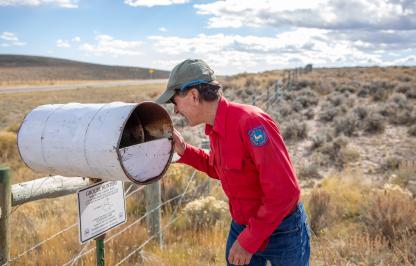Whether you are after pronghorn along the plains, deer or elk in the mountains, bighorn sheep high in the mountains or birds along the flatlands and wetlands, check out the 2022 Wyoming Game and Fish Department hunting forecast from eight regions around the state. The forecasts from each region are based on data and observations from the field by department biologists and game wardens.
A few reminders:
Before heading out be sure to review the 2022 hunting regulations for any season changes.
Hunters who harvest a deer or elk in any of the state’s chronic wasting disease focus areas are encouraged to get it tested. For the Laramie Region, there is mandatory samplling required for mule deer harvested in hunt areas 59, 60, 64 and 65 in the Laramie Mountains. The information is incredibly valuable and will help Game and Fish’s long-term monitoring and management efforts.
Here's the 2022 hunting forecast for the Laramie Region
Pronghorn
Population trends and corresponding hunting opportunities vary substantially across the region. Grassland herds in the north and east, including Hunt Areas 38, 11, 34 and 103, have declined over the past five years, along with notable decreases in fawn production. Decent buck numbers remain in these herds, but older animals will be harder to find. Sportspersons should expect to see fewer pronghorn in the Laramie Valley and Shirley Basin compared to previous years with reduced hunting opportunities. However, populations in Hunt Areas 47 and 48 are experiencing an increase. Pronghorn in Hunt Area 50 are performing well. The southwest portion of the Platte Valley, specifically Hunt Area 51, saw a slight reduction in the population so doe/fawn licenses were reduced. Due to low summer precipitation in much of the region, similar to 2021, pronghorn likely will be concentrated near wet meadows and other water sources.
Mule deer
Populations in the Platte Valley and Shirley Mountain herds have been stable to slightly increasing the past four years. The Mullen Fire, which consumed over 176,000 acres in 2020, has greatly altered the landscape in the Snowy Range. The population within the Sheep Mountain herd has been on a steady decline the past several years, however, regeneration of important grass and shrub species indicated the burn will have long-term, positive effects for fawn rearing and survival. Hunters should be prepared for downed timber on the U.S. Forest Service road system. Buck ratios remain high across the Platte Valley, which allows for increases within hunt areas that can afford additional pressure. If moderate weather conditions continue into the fall, hunters will most likely locate deer in higher-elevation summer and transition ranges. Poor fawn production coupled with high chronic wasting disease prevalence continues to suppress populations in the Goshen Rim and Laramie Mountains herds. Hunters may struggle to find older deer, and should be prepared to hunt harder than normal if they are looking for a trophy buck. CWD sample submission is mandatory in Hunt Areas 59, 60 and 64. Check stations and Game and Fish personnel will be present throughout the season to assist with the mandatory collection effort.
Elk
Populations remain above objectives with ample harvest opportunities throughout the region. The Mullen Fire will likely contribute to the already over-objective herds by setting plant communities back to an early successional stage, which typically improves calf and adult survival. Hunters are encouraged to hunt south of Wyoming Highway 130 within the Snowy Range herd to take advantage of elk utilizing the burn scar where these vegetation improvements occurred. There were several changes made to the Snowy Range herd hunt areas as well as the Shirley Mountain herd so hunters should become familiar with the dates and limitations prior to going to the field. Given hunting pressure on public land, sportspersons should be prepared to pursue elk in areas that are a fair distance from well-traveled roads and trails. Look for additional access opportunities on Game and Fish hunter management areas, and walk-in areas, and be sure to secure a permission slip.
Bighorn Sheep
Hunting should be excellent throughout the Laramie region. Hunt areas 18 and 21 are open for the 2022 season. Hunters typically experience better than 90% success in the Douglas Creek, Encampment River and Laramie Peak herds. The same is expected this year. The Mullen Fire burned within areas bighorn sheep prefer so habitat is expected to improve within the Douglas Creek herd.
Moose
Excellent hunting opportunities are expected in the Snowy Range herd. Harvest success across Type 1 and Type 4 licenses continues to be exceptional, and the herd maintains high bull ratios and good calf production. Regrowth from the Mullen Fire is expected to improve moose habitat.
Upland game
Average to below-average precipitation across the region will result in marginal brood survival for upland game birds, particularly sharp-tailed grouse, pheasants and sage grouse. Dusky or blue grouse should be in better shape given descent precipitation events in the higher elevations as well as vegetation recovery within the Mullen Fire. The department will continue to stock pheasants for the Springer special hunt as well as for the general season throughout November and a portion of December on areas enrolled in the Access Yes program and the Springer WHMA. Release sites will be available to the public prior to Nov. 1, which is the opening date for the general pheasant season.
Drought conditions
Drought conditions in southeast Wyoming were as severe or worse than in 2021, particularly within eastern Albany, Platte, Goshen and Laramie counties. However, further away from those areas there were significantly more precipitation events so hunters can expect to see ungulates more spread out across the landscape. Average to poor juvenile survival is expected which will affect what hunters see on the landscape for big game species.




